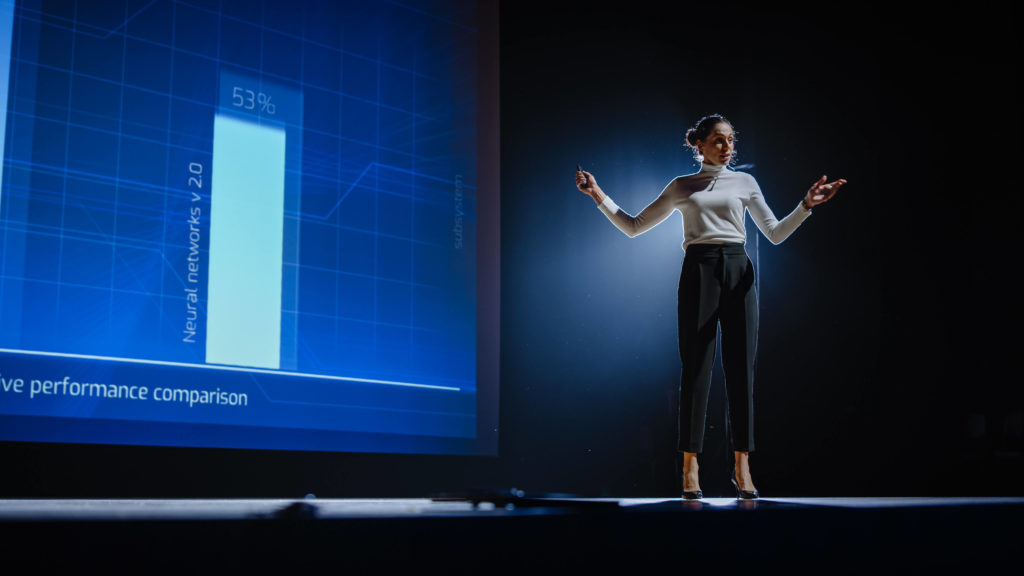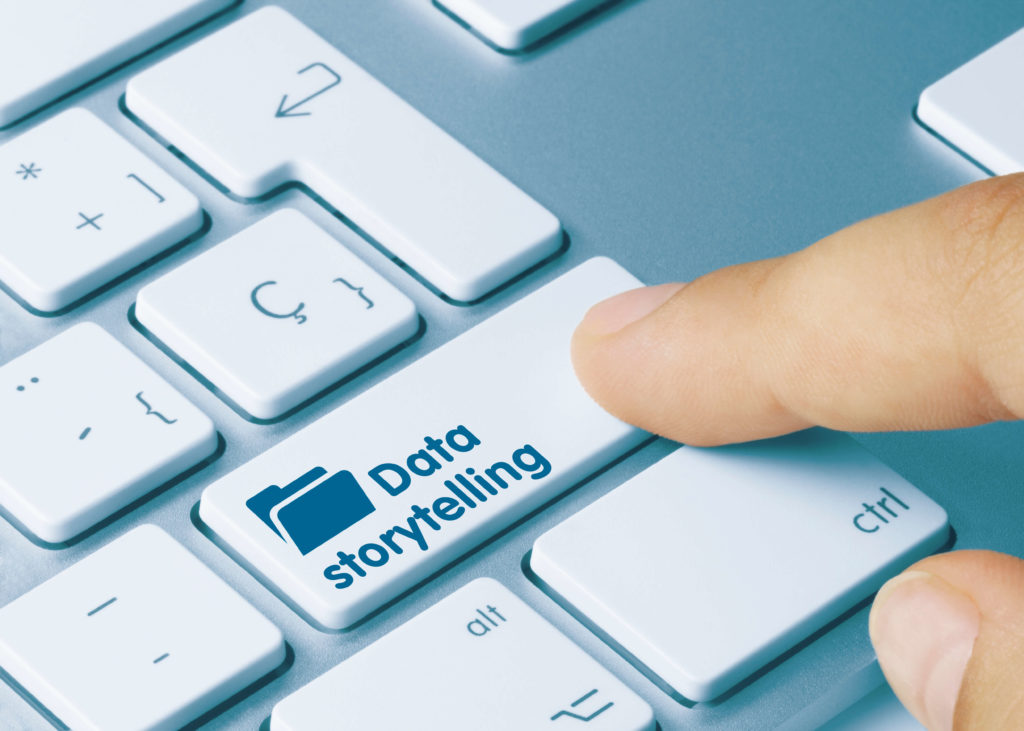Contents
We use presentations to communicate information to an audience. And a successful presenter is skilled in the art of data storytelling.
Storytelling sounds like we are referring to children, but we are not. Surprisingly, the average attention span of an adult is very short. Thus, an effective presenter must use data storytelling to redirect their audience to their presentation.
I’m sure we all remember that high school teacher that would lecture for an entire hour. There were no visuals, and only the sound of a monotone voice that seemed to drone on forever. Was anyone truly engaged?
Data storytelling is the newest style of communication that is sweeping the business world. It is no longer just the financial analysts expected to base their goals on data, and we hope people use data to inform their business decisions.
What Is Data Storytelling?

Data storytelling is used to communicate information to a target audience. A presenter uses a story to explain the analyzed data, and the data results are used to inform employees.
We have become a data-driven society. We collect data, study the data, and then create goals based on the data. Businesses rely on data to steer their business plans in the right direction.
The data and goals often have to be shared with colleagues, so presentations with data storytelling have become the new norm to communicate information. The days of plain pie charts are things of the past. Sure, you can still use pie charts, but they should be accompanied by so much more.
Becoming proficient in the art of data storytelling requires several skills. Great presenters know computer science, statistics, artistic design, and storytelling.
What Makes a Good Data Story?

Consider a children’s book. Children are captivated by colorful images, and they wait enthusiastically for the story to unfold.
You might not attain this level of enthusiasm with your audience, but your goal should be to keep them engaged for the entirety of your presentation. It would help if you considered several things when creating your presentation.
Confidence
Your confidence level is very evident when you are presenting to an audience. Educating yourself on the data that you are offering is a must.
In addition to the data, you should be comfortable with the technology you are using to display your visuals. The silence can be deafening when a presenter tries to get their visuals up on a screen.
You should also be knowledgeable about the expected outcome of your presentation. A presenter should be able to help his audience determine the goals that they hope to achieve.
Help Improve Data Literacy
One of the goals of your presentation should be to help improve the data literacy of your audience.
Data literacy is the ability to read and analyze data. Most companies use data to set goals, so all employees must be working towards acquiring this skill.
As a presenter, you should be able to deliver data in a clear, concise manner that everyone understands.
Remembering that adults have short attention spans, simplify the data as much as possible while retaining the critical aspects.
Data Relevancy
When presenting, you should always stay on topic. Colleagues will appreciate brevity, and it is best to ensure that your data is relevant to your story and vice versa.
Current Data
When crafting your story, it is best to use the most current data. You should use data that helps your story unfold while ultimately meeting your audience’s goal.
Avoid any data that is not relevant to your storyline. You can give too much data, and you do not want your audience to feel overwhelmed.
It would be best if you kept comments about visuals very brief. It would be best to allow your audience to study the images without interruption. Pausing once in a while will allow your audience the time to process the data you are offering fully.
Clear Storyline
It would help if you crafted your story with a clear introduction to the presented data. You then show the relevant data, and finish your presentation with a short conclusion that has a call to action.
Remember that you are telling a story. It would be best if you tried to be entertaining. Maybe even throw in a joke or two.
Once your audience has heard your presentation, they should be ready to determine their next steps. They should have the information they need to set their goals or make a plan for moving forward.
The Importance of Visuals
The visual representation of your data can make or break your presentation. The presentation of raw data can become quite tedious, even for those invested in the topic. Sometimes, it is necessary to present a great deal of data and finding the most entertaining way to show it will ensure the success of your presentation.
Humans are very receptive to visual displays, and visuals are processed much faster than text. It only makes sense to take advantage of this to engage your audience.
The goal of any visual display is to communicate data or information clearly and effectively. Creating these displays combines art with data science, and colorful pictures and images can help keep an audience engaged.
When creating your visual displays, you want to make the data engaging for your audience, and you want to grab their attention and keep it.
Visual displays should identify trends, reinforce arguments or opinions, or highlight important aspects of the data. They can show significant amounts of raw data in easily understandable visuals.
Types of Visual Displays
There are several different types of visuals that you can use. As a presenter, you should remember that variety is the spice of life. Combining other visuals in your presentation will help keep your audience engaged.
Infographics
Infographics use imagery and charts with minimal text. The beauty of infographics is that they can convey a great deal of data with images rather than text. Luckily, there is an infographic for every type of data. There are infographics for:
- Statistics
- Information
- Timeline
- Process
- Geography
- Comparison
- Hierarchical
- list
Charts
Charts are the most commonly used because of their versatility.
- Bar charts
- Line charts
- Bubble charts
- Stacked bar charts
- Treemaps
- Word clouds
- Pictographs
- Area charts
- Scatterplot
Diagrams
You can easily organize data in several types of diagrams. They are:
- Flowcharts
- Mindmaps
- Venn diagrams
- Treemaps
- SWOT analysis
- Fishbone diagrams
- Histograms
- Wireframes
Fortunately, you don’t have to be a computer genius to create these visuals. Many analytics tools at your disposal will help you make the best visual displays for your presentation.
Analytics Tool With Advanced Dashboard Functionality
This analytics tool with advanced dashboard functionality helps you organize your data into creative and engaging visual displays. There is a dashboard that effortlessly guides you through the process.
The dashboard will help you choose colors, fonts, and designs for your displays. This tool will allow the user to compile complex data into easy-to-understand charts, graphs, or diagrams.
The dashboard offers many options that will allow the user to choose the best choice for the show. This allows the user complete control of the final design of the visual display.
You will not find an easier way to organize your data.
How To Improve Your Presentation With Data Storytelling
Here are six simple steps to improve your presentation with data storytelling.
1. Identify The Purpose
Determine why you are giving the presentation. It would be best if you got to know your audience. What do they need from you? What kind of data do they need from you?
2. Find The Data
Find current data that is relevant to your presentation. What data does your audience need to achieve their goals? How can you keep your audience engaged?
3. Outline Your Story
Once you have found the relevant data, you must create your story to present the data clearly and engagingly. The purpose of your account must be to deliver the data most efficiently.
4. Find an Analytics Tool To Create Your Visuals
This step requires the most time and effort. It would be best if you created visuals that will show your data in a way that can be processed and understood by your audience. Your story will help, but your visuals should speak for themselves.
5. Review
Go over your presentation and ensure that you have everything covered. Make sure that you are knowledgeable about everything that you are sharing. You need to anticipate any questions from your audience and craft potential answers.
6. Finalize Your Visuals
Study your visuals and make sure you have everything you need to help with your story. It is also best to make sure that your visuals are not cluttered. Beware of putting too much information on your visuals.
Final Thoughts
Improving your presentations through data storytelling will take a little time and creativity, but it is well worth it. Your audience will appreciate the transparent nature of your presentation.
Sure, studying data can be a tedious part of the workday, but dynamic presentations can make it less painful.
And the success and growth of many businesses depend on the analysis of data. They can make goals or changes to their business plans when they know the numbers.

